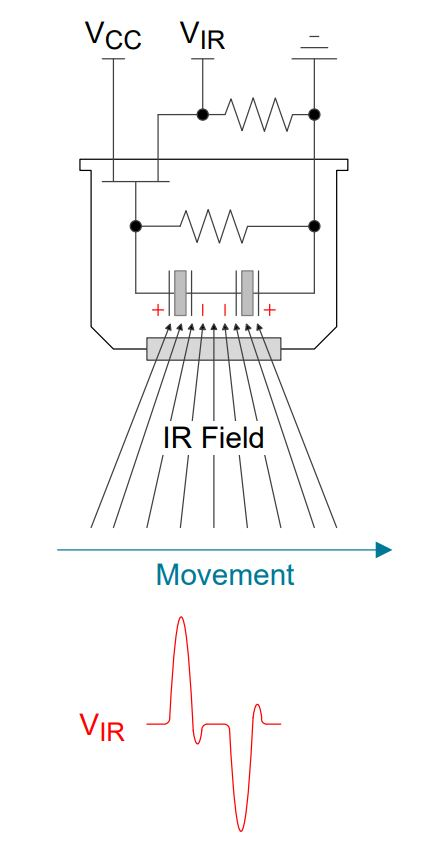SLLA603 March 2023
2 Technical Overview
PIR-based technology relies on the movement of heat across a field of view. Two pyroelectric elements arranged with opposing orientations create an AC voltage response as an object moves in front of the elements.
#GUID-FAD15D2C-718C-46CA-B1BD-A17D3701D99E demonstrates the produced AC signal from a PIR sensor that detects movement. As an object passes in front of the first sensor, a negative response is generated, and a positive response is generated as the object passes in front of the second sensor. The direction of the subject changes which response is generated first. In addition, the distance of the object changes the amplitude of the signal, with a subject that is farther away generating a smaller signal, effectively limiting the range of a sensor. The speed that the object passes in front of the sensor determines the frequency of the signal, being higher with faster moving objects.
 Figure 2-1 Voltage Response of Movement
in Front of a PIR Sensor
Figure 2-1 Voltage Response of Movement
in Front of a PIR SensorSince a PIR sensor effectively uses two separate sensors to generate a voltage response with motion, this makes the PIR sensor a cheap and effective use for detecting moving objects. However, there are significant challenges that come from trying to detect stationary objects. Namely, a stationary object cannot generate any detectable response. However, with the use of a mirror, motion can be feigned, tricking the PIR sensor into detecting a stationary object as moving.
This can be done by pointing a PIR sensor at a mirror and rotating the mirror across a field of view, similar to #GUID-EF11E809-8A56-405E-84FD-A1363F855349.
#GUID-EF11E809-8A56-405E-84FD-A1363F855349 demonstrates that through this method the PIR sensor detects a still object panning across the field of view. This is enough to trigger a differential response from the sensor, and can be used to detect stationary subjects.